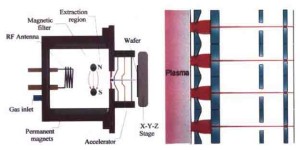APPLICATION OF TECHNOLOGY:
- Lithography
- Semiconductor doping/ion implantation
- High resolution scanning ion microscopy
- Failure analysis and design modification for integrated circuit fabrication
- Repair of optical and x-ray lithography masks
- Micromachining
ADVANTAGES:
- Ion beam current on the order of microamps for high throughput
- Feature sizes potentially as small as 0.1 µm
- Short accelerator system – 20 mm in length
- Multibeamlet arrangements with a single ion source can be used to increase throughput
- High source brightness
- Compact and inexpensive
ABSTRACT:
Ka-Ngo Leung and colleagues have developed a patented focused ion beam (FIB) system that can produce a final beam spot as small as 0.1 µm while producing an ion beam current on the order of tens of nanoamps. Conventional FIB systems have a current of nanoamps or picoamps, which is acceptable for mask repair but not for lithography where higher throughput is necessary.
The Berkeley Lab FIB system is uniquely designed so that the ratio of the diameter of the hole or aperture in the plasma electrode to the thickness of the electrode is sufficiently large to produce a current that is orders of magnitude greater than that produced by conventional FIB systems. Additional electrodes are used to accelerate and focus produce the final beam. As few as five electrodes can be used, providing a very compact FIB accelerator system that can be as short as 20 mm.
The system can be used for maskless and direct (photoresist-less) patterning and doping of films in semiconductor fabrication. Patterns are created by deflecting the individual ion beamlets exiting the electrode and/or by manipulating the substrate. A single ion source can be designed to produce multiple beamlets for increased throughput.
Berkely Lab is also seeking a qualified partner(s) to help with the development of a new manufacturing technique for cardiac stents. For more information, please visit here.
STATUS: US Patent #5,945,677. Available for licensing or collaborative research
REFERENCE NUMBER: IB-1217
SEE THESE OTHER BERKELEY LAB TECHNOLOGIES IN THIS FIELD:
